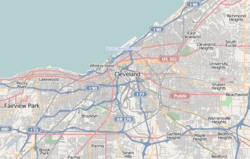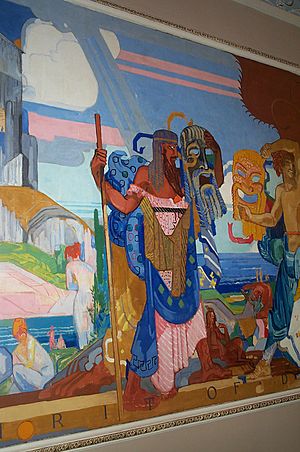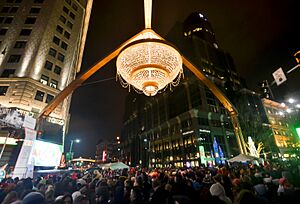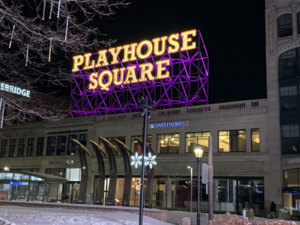Playhouse Square facts for kids
Quick facts for kids |
|
|
Playhouse Square
|
|
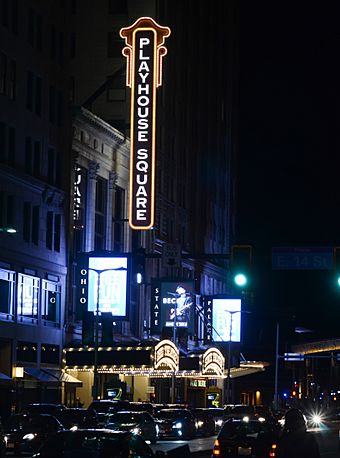
|
|
| Location | 2067 E. 14th St.; 1422, 1501, 1515, 1621 Euclid Ave., Cleveland, Ohio |
|---|---|
| Built | 1921 |
| Architect | Rapp and Rapp |
| Architectural style | Late 19th and 20th Century Revivals, Classical Revival, Other |
| NRHP reference No. | 78002041 |
| Added to NRHP | October 5, 1978 |
Playhouse Square is a super cool theater area in downtown Cleveland, Ohio. It's one of the biggest places for performing arts in the United States, right after Lincoln Center in New York City. These theaters were built really fast in the early 1920s and became a huge entertainment spot for Cleveland for many years.
However, by the late 1960s, the area became less popular, and its theaters closed down. In the 1970s, people worked together to bring the district back to life. This effort helped start a new time of growth for downtown Cleveland. Because of this, the return of Playhouse Square is often called "one of the top ten successes in Cleveland history."
Contents
History of Playhouse Square
Building the Theaters
After World War I, a local builder named Joseph Laronge had a big idea. He wanted to create a row of theaters on Euclid Avenue. This street was between East 14th and East 17th streets. Laronge teamed up with a New York City business leader, Marcus Loew, and others. They formed a group called Loew's Ohio Theatres. Their goal was to develop this area.
The first two theaters were the Ohio and State (now called the KeyBank State). Famous architect Thomas W. Lamb designed them. They were built in the Italianate style. It was important for the theater signs to face Euclid Avenue. The State Theatre was built at the back of its lot because of limited space. But its lobby shared the front space with the Ohio Theatre. Building started in 1920, and both theaters opened in early February 1921.
Across Euclid Avenue, the Hanna Theatre opened in late March 1921. It was part of the Hanna Building complex. Charles A. Platt designed it. Even though it faces East 14th Street, it is still part of Playhouse Square. It was named after a well-known Cleveland Senator, Mark Hanna.
Next door, the Bulkley Building was being built. It would house the Allen Theatre. C. Howard Crane designed the Allen Theatre. It was finished in early April 1921. Jules and Jay Allen's Pompeiian-style theater was sold to Loew's in 1922.
The last theater built was the Palace Theatre. It is now known as the Connor Palace. It opened in November 1922 inside the Keith Building. At that time, the Keith Building was the tallest in Cleveland. A huge electric sign, the largest in the world, lit up to announce the Palace was open. Edward F. Albee built the Palace. He built it to honor his friend and business partner, B.F. Keith. The Palace was called the "Showplace of the World." Elsie Janis, a famous mimic, was the main act. Eduardo Cansino, Rita Hayworth's father, also performed. Albee spent over $2 million on this vaudeville theater. It became known as the "swankiest theater in the country."
The Chicago architectural firm of Rapp and Rapp designed the Palace. It was a main theater for the Keith-Albee chain of vaudeville shows.
The area around these theaters soon became known as "Playhouse Square." A local group tried to rename it "Euclid Square." But their efforts didn't work. The area is now officially called "Playhouse Square."

Closing and Rebirth
For over 40 years, the theaters successfully showed plays, vaudeville acts, and movies. But after World War II, many people moved to the suburbs. Also, television became popular. These changes caused the theaters to decline. A fire broke out in the Ohio Theatre in 1964. Other Playhouse Square theaters were damaged by vandals. Between May 1968 and July 1969, all the theaters closed. Only the Hanna Theatre stayed open.
Plans to reopen and fix the theaters started almost right away. In 1970, Raymond K. Shepardson, who worked for Cleveland Public Schools, formed a group. It was a non-profit group called the "Playhouse Square Association." He formed it with the Junior League of Cleveland, Inc. The cover of the February 27, 1970, issue of Life magazine showed a large mural. It was James H. Daugherty's The Spirit of Cinema America from the State Theatre's lobby.
In 1972 and 1977, there were plans to tear down the Ohio and State Theatres. This caused a big public outcry. In 1973, the new Playhouse Square Foundation got long-term leases for the Palace, Ohio, and State Theatres. Also, Cuyahoga County officials bought the Loews Building. In 1973, a musical show called Jacques Brel is Alive and Well and Living in Paris opened in the State Theatre lobby. It was supposed to run for two weeks. Instead, it played for two and a half years! In 1978, Playhouse Square was added to the National Register of Historic Places.
Theater Renovations
The huge success of Jacques Brel encouraged the restoration of the theaters. Various public-private partnerships raised about $40 million for the project.
The Ohio Theatre had a lot of fire damage. It was originally planned to be the last theater to be fixed. But those plans changed. The theater was renovated faster to become the home of the Great Lakes Shakespeare Festival. This festival is now called Great Lakes Theater. The $4 million project started in late 1981. It was finished in less than nine months. Work began on the State Theatre in May 1979. It was completed in the summer of 1984. A new $7 million stagehouse was added. The renovation of the theater's three lobbies finished in 1987. Restoration of the Palace Theatre started in 1987 and was done the next year. As part of this project, more parking was added to the complex.
The Allen Theatre's reconstruction was slower than the others. Some people thought three theaters were enough for the area. However, in 1993, the Playhouse Square Foundation agreed to rent the theater. They planned to buy it, which they did in 1997. This purchase made Playhouse Square the largest performing arts complex outside of New York. It had more than 10,000 seats. The Allen Theatre reopened in 1998.
The Hanna Theatre was the only one that didn't close in 1968 or 1969. But it was overshadowed by the other theaters' rebirth in the 1980s. It closed in 1989. However, the Hanna reopened in March 1996. This was its 75th anniversary. In 1999, the Playhouse Square Foundation bought the Hanna. This made it the fifth and last of the original theaters bought by the foundation.
The Cleveland Theater District Development Corporation (CTDDC) was created in 1998. It is now called the Playhouse Square District Development Corporation (PDDC). This group helps improve the theater district.
Recent Years
The reopening of the State, Ohio, and Palace Theatres encouraged more development. This included the $40 million Renaissance Office Building. A Wyndham Hotel at Playhouse Square also opened.
In 1999, Playhouse Square started a Real Estate Services Division. This was unusual for a non-profit arts center. Playhouse Square helps develop the area. This makes it a fun and welcoming place for visitors. It also creates a strong business environment.
In 2002, Playhouse Square opened the 14th Street Theatre. It was home to Second City Cleveland. It hosted comedy shows and unique performances. This venue closed in 2013. It was changed into a private dining space called Cibreo Privato. This is part of the Italian restaurant Cibreo.
In 2003, part of East 14th Street near Playhouse Square was renamed. It became Memory Lane-Bob Hope Way. This honored the famous entertainer Bob Hope on his 100th birthday. He had lived in Cleveland for a long time.
Playhouse Square and Cleveland's public broadcasting stations worked together. They raised money to turn the One Playhouse Square Building into the Idea Center at Playhouse Square. It opened in 2005. It is now home to Playhouse Square's community programs. It is also the downtown office for radio stations WKSU and WCLV. Plus, TV station WVIZ is there. They are all part of Ideastream Public Media.
In 2008, the HealthLine opened with a station at Playhouse Square. This line connects Public Square to University Circle. It also goes to the Cleveland Clinic.
Also in 2008, the Hanna Theatre was fully renovated. Its stage was improved with a new hydraulic lift system. The Hanna is now home to Great Lakes Theater. This is Cleveland's classic theater company. They used to perform at the Ohio Theatre.
Three groups worked together in a project called "The Power of Three." These were Cleveland Play House, Cleveland State University, and Playhouse Square. They created the Allen Theatre Complex. It has a redesigned Allen Theatre, which reopened in 2011. Two new theaters opened in 2012. Cleveland Play House and Cleveland State University's Department of Theatre and Dance are now based at Playhouse Square. The Cleveland Play House offices and all of Cleveland State University's arts programs are in the Middough Building. This adds to the lively neighborhood.
Playhouse Square welcomes over 1 million guests each year. They attend more than 1,000 performances and events. Its KeyBank Broadway Series has over 45,000 season ticket holders. This is the largest in the country. Cleveland is one of the few cities that can host a three-week Broadway show tour.
Improvements to the Playhouse Square neighborhood finished between April 2013 and April 2014. These included digital signs and upgrades to U.S. Bank Plaza. A cool retro sign and the GE Chandelier were added. The chandelier is the world's largest outdoor chandelier. It is above Euclid Avenue and East 14th Street. A ceremony called "Dazzle the District" happened on May 2, 2014. In 2014, a $100 million fundraising campaign started. The Chris Connor family of Cleveland gave $9 million. In honor of their gift, the Palace Theatre was renamed Connor Palace. In 2017, KeyBank gave $10 million. In honor of their gift, the State Theatre was renamed KeyBank State Theatre.
In April 2018, Playhouse Square began building The Lumen. This is a 34-story apartment tower. It added 318 apartments to downtown Cleveland. It also has a 550-space parking garage. The Tower opened in 2020.
Theaters at Playhouse Square
- Allen Theatre
- Connor Palace
- Hanna Theatre
- The Helen Rosenfeld Lewis Bialosky Lab Theatre
- Kennedy's Cabaret
- KeyBank State Theatre
- Mimi Ohio Theatre
- Outcalt Theatre
- Upper Allen
- Westfield Studio Theatre
Resident Performing Groups
- Cleveland Ballet
- Cleveland Play House (Allen Theatre)
- Cleveland State University Department of Theatre and Dance (Allen Theatre)
- DANCECleveland
- Great Lakes Theater (Hanna Theatre)
- Tri-C Jazz Fest


